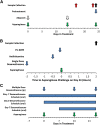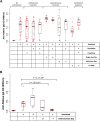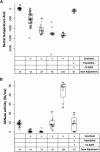Effect of premedications in a murine model of asparaginase hypersensitivity
- PMID: 25573198
- PMCID: PMC4352598
- DOI: 10.1124/jpet.114.220780
Effect of premedications in a murine model of asparaginase hypersensitivity
Abstract
A murine model was developed that recapitulates key features of clinical hypersensitivity to Escherichia coli asparaginase. Sensitized mice developed high levels of anti-asparaginase IgG antibodies and had immediate hypersensitivity reactions to asparaginase upon challenge. Sensitized mice had complete inhibition of plasma asparaginase activity (P = 4.2 × 10(-13)) and elevated levels of mouse mast cell protease 1 (P = 6.1 × 10(-3)) compared with nonsensitized mice. We investigated the influence of pretreatment with triprolidine, cimetidine, the platelet activating factor (PAF) receptor antagonist CV-6209 [2-(2-acetyl-6-methoxy-3,9-dioxo-4,8-dioxa-2,10-diazaoctacos-1-yl)-1-ethyl-pyridinium chloride], or dexamethasone on the severity of asparaginase-induced allergies. Combining triprolidine and CV-6209 was best for mitigating asparaginase-induced hypersensitivity compared with nonpretreated, sensitized mice (P = 1.2 × 10(-5)). However, pretreatment with oral dexamethasone was the only agent capable of mitigating the severity of the hypersensitivity (P = 0.03) and partially restoring asparaginase activity (P = 8.3 × 10(-4)). To rescue asparaginase activity in sensitized mice without requiring dexamethasone, a 5-fold greater dose of asparaginase was needed to restore enzyme activity to a similar concentration as in nonsensitized mice. Our results suggest a role of histamine and PAF in asparaginase-induced allergies and indicate that mast cell-derived proteases released during asparaginase allergy may be a useful marker of clinical hypersensitivity.
U.S. Government work not protected by U.S. copyright.
Figures








Similar articles
-
Hypersensitivity reactions to asparaginase in mice are mediated by anti-asparaginase IgE and IgG and the immunoglobulin receptors FcεRI and FcγRIII.Haematologica. 2019 Feb;104(2):319-329. doi: 10.3324/haematol.2018.199448. Epub 2018 Sep 20. Haematologica. 2019. PMID: 30237274 Free PMC article.
-
Premedication strategy for weekly paclitaxel.Cancer Invest. 2002;20(5-6):666-72. doi: 10.1081/cnv-120003535. Cancer Invest. 2002. PMID: 12197222
-
Oral premedication for the prevention of hypersensitivity reactions to paclitaxel.Med Oncol. 2008;25(3):274-8. doi: 10.1007/s12032-007-9030-2. Epub 2008 Mar 25. Med Oncol. 2008. PMID: 18363113
-
Premedication Protocols to Prevent Hypersensitivity Reactions to Chemotherapy: a Literature Review.Clin Rev Allergy Immunol. 2022 Jun;62(3):534-547. doi: 10.1007/s12016-022-08932-2. Epub 2022 Mar 8. Clin Rev Allergy Immunol. 2022. PMID: 35258842 Review.
-
Prophylaxis for paclitaxel hypersensitivity reactions.Ann Pharmacother. 2001 Sep;35(9):1114-7. doi: 10.1345/aph.10287. Ann Pharmacother. 2001. PMID: 11573863 Review.
Cited by
-
Genetic inhibition of NFATC2 attenuates asparaginase hypersensitivity in mice.Blood Adv. 2020 Sep 22;4(18):4406-4416. doi: 10.1182/bloodadvances.2020002478. Blood Adv. 2020. PMID: 32931581 Free PMC article.
-
Hypersensitivity reactions to asparaginase in mice are mediated by anti-asparaginase IgE and IgG and the immunoglobulin receptors FcεRI and FcγRIII.Haematologica. 2019 Feb;104(2):319-329. doi: 10.3324/haematol.2018.199448. Epub 2018 Sep 20. Haematologica. 2019. PMID: 30237274 Free PMC article.
-
Hypersensitivity reactions associated with L-asparaginase administration in 142 dogs and 68 cats with lymphoid malignancies: 2007-2012.Can Vet J. 2016 Feb;57(2):176-82. Can Vet J. 2016. PMID: 26834270 Free PMC article.
-
L-Asparaginase Isolated from Phaseolus vulgaris Seeds Exhibited Potent Anti-Acute Lymphoblastic Leukemia Effects In-Vitro and Low Immunogenic Properties In-Vivo.Int J Environ Res Public Health. 2016 Oct 14;13(10):1008. doi: 10.3390/ijerph13101008. Int J Environ Res Public Health. 2016. PMID: 27754445 Free PMC article.
-
Hepatoprotective effect of nanoniosome loaded Myristica fragrans phenolic compounds in mice-induced hepatotoxicity.J Cell Mol Med. 2022 Nov;26(21):5517-5527. doi: 10.1111/jcmm.17581. Epub 2022 Oct 12. J Cell Mol Med. 2022. PMID: 36226354 Free PMC article.
References
-
- Albertsen BK, Schrøder H, Jakobsen P, Avramis VI, Müller HJ, Schmiegelow K, Carlsen NT. (2002) Antibody formation during intravenous and intramuscular therapy with Erwinia asparaginase. Med Pediatr Oncol 38:310–316. - PubMed
-
- Asselin BL. (1999) The three asparaginases. Comparative pharmacology and optimal use in childhood leukemia. Adv Exp Med Biol 457:621–629. - PubMed
-
- Asselin BL, Ryan D, Frantz CN, Bernal SD, Leavitt P, Sallan SE, Cohen HJ. (1989) In vitro and in vivo killing of acute lymphoblastic leukemia cells by L-asparaginase. Cancer Res 49:4363–4368. - PubMed
-
- Baechtel S, Prager MD. (1973) Basis for loss of therapeutic effectiveness of L-asparaginase in sensitized mice. Cancer Res 33:1966–1969. - PubMed
-
- Berenstein EH, Garcia-Gil M, Siraganian RP. (1987) Dexamethasone inhibits receptor-activated phosphoinositide breakdown in rat basophilic leukemia (RBL-2H3) cells. J Immunol 138:1914–1918. - PubMed
Publication types
MeSH terms
Substances
Grants and funding
LinkOut - more resources
Full Text Sources
Other Literature Sources
Medical

